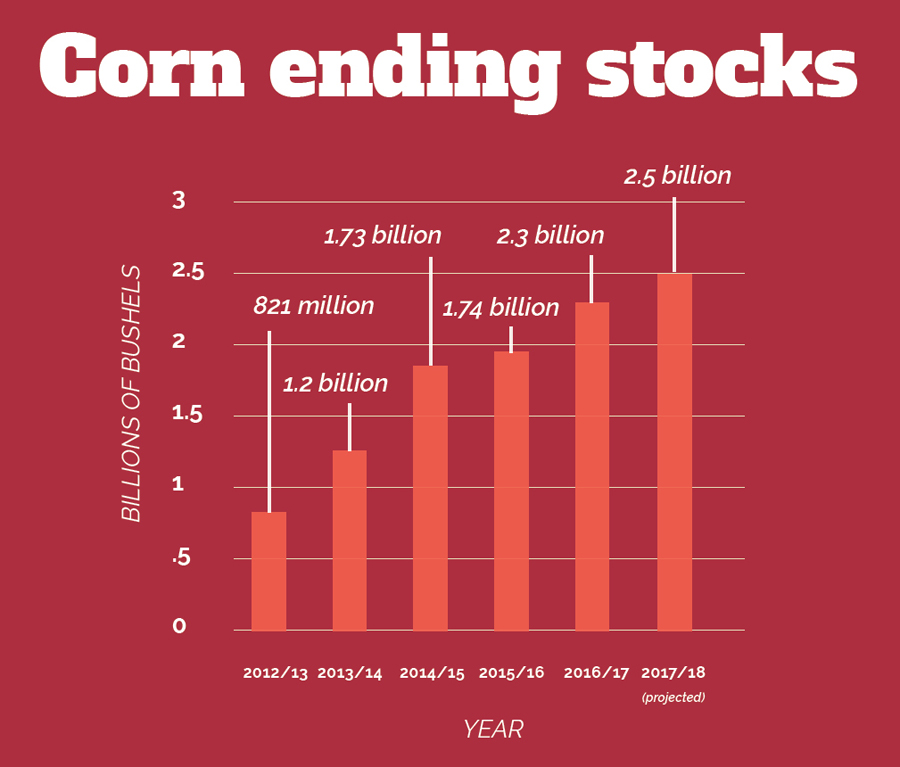Over the last few harvests, the status quo for corn producers has meant a “slow bleed”: four straight seasons of a steady drop in prices (from $6.89 to $3.36 per bushel) and increased carryouts, or “ending stocks,” the amount left over after the immediate need for a grain has been met (from 821 million to 2.3 billion bushels).
The United States Department of Agriculture (USDA) projections for the current 2017-18 corn harvest? Another price drop, to $3.20 per bushel. And another uptick in corn carryout, to 2.5 billion bushels.
Unfortunately for farmers, that’s more status quo. It’s more of what Dean Watson, the President of POET Grain, calls a “slow bleed.”
“It’s the worst of all worlds right now,” says Watson. “It’s a slow bleed, and that’s the most painful, because it’s not so dramatic as to get national or world attention. So you’ve got these corn producers out there just scrapping and fighting and trying to figure out a way to make ends meet.”
Watson would know. POET Grain buys 650 million bushels of grain — nearly 5 percent of the U.S. corn crop — per year. With that grain, the company uses the starch to produce 1.8 billion gallons of biofuels, and the protein, fat and fiber is converted to distillers grains, corn oil and other renewable products.
“The producers are holding on to corn as long as they can,” says Watson. “The problem with holding on as long as you can is that the world knows there’s 2.5 billion bushels of corn inventory at the end of the year. About the time you get to July or August there’s still 2.5 billion bushels out there and the world knows you’re going to have to move it. That’s why things won’t get better unless we make some changes.”
Scott Irwin, the Laurence J. Norton Chair of Agricultural Marketing at the University of Illinois at Urbana- Champaign, agrees that something has to change. He stresses that more of the same means long-term problems for farmers.
“If we continue going as we’ve gone the last four years, financial conditions will worsen,” says Irwin. “Lots of crop operations have pretty much used up all their working capital. We’ll be at a real inflection point in another year or two. Farms will close.”
Irwin’s lifelong fascination with commodity markets started as a young boy on his family’s Iowa farm, tagging along with his dad to the local grain elevator to check the latest prices. Today, he studies those variables that can affect future markets. Irwin does believe that one variable — weather — could play a role in reducing that corn crop in coming years. But he also stresses that it’s not something we can plan for, or rely on, in order to cut down on carryout.
“Essentially, the U.S. has had only one really poor crop in the last 22 years,” says Irwin. “It’s the most remarkable run of 20-plus years of favorable Midwest weather for growing corn since the start of weather records in the U.S. going back to 1895. We would need to knock a billion bushels off next year’s corn crop somehow before you would really put a dent in the price. That’s a lot. We can’t count on bad weather to change this. We have to count on the things we can control.”
Those controllables start with communication, according to Anne Steckel, Biofuel Adviser for the National Farmers Union (NFU). And then that communication needs to be converted into public education, which can eventually help drive policy.
“The amount of education and advocacy that’s being done on behalf of the renewable fuels industry is starting to pay off,” says Steckel, who works directly with legislators from her Washington, D.C. office. “I’m starting to see more members of Congress really understand the benefits of ethanol, especially after we got past the whole food and fuel discussion, and after people saw that that was nothing but a red herring. The challenge is to continue to educate the consumer about the price at the pump, and what’s in their gasoline and why ethanol is good for all of us.”
Steckel, whose dad worked for John Deere in Moline, Ill., has turned those agricultural ties into a desire to drive pro-agriculture — and pro-biofuels — policy.
She points to two of those policies — the continued support of the Renewable Fuel Standard, or RFS, the federal program requiring that increasing amounts of renewable fuels be blended into the nation’s transportation fuel, and an expansion of the Reid Vapor Pressure (RVP) waiver, which currently places limits on E15 sales during summer months — as quick fixes to help soak up that extra corn.
“We know there’s a lot of available corn out there,” Steckel says. “That’s part of the reason the NFU has doubled down on their efforts to advance biofuels. We see ethanol as a very viable way to use our corn to help ensure that prices are where farmers want them to be. That could, and should, happen right now if Congress really wants to make a difference. We have the opportunity to move corn, and instead it’s sitting.”
Jay Schutte, a farmer in Benton City, Mo., is also the chairman of National Corn Growers Association’s (NCGA) Ethanol Action Team. He and the NCGA also believe that a strong RFS and the removal of the RVP will support a market-based solution for improving the agriculture economy.
In order for biofuel production to use additional starch, Schutte says, “We must maintain a strong RFS, remove the outdated and unnecessary RVP barrier, and continue to look for ways to getting midlevel ethanol blends into the market to help automakers meet more stringent emissions and efficiency requirements. Importantly, a growing global demand for renewable fuels will help increase exports and draw down the corn surplus.”
Like the NFU, the NCGA also points to trade troubles when it comes to exporting biofuels, especially into those markets that punish our products with tariffs.
“The United States leads the world in ethanol production and exports, and is currently responsible for 60 percent of global production and 45 percent of exports,” says Schutte. “The United States leads on biofuel exports because our ethanol wins on price, we have a stable supply, and global demand for renewable fuels is rising. NCGA will back efforts to develop new markets and work with our partners such as the U.S. Grains Council to effectively address barriers that other countries erect to our exports.”
Darrin Ihnen, who has a corn and soybean farm in Hurley, S.D., is one farmer who is sitting on excess yields. “Everything for now went to the bin,” he says. “We hope prices will turn around, but I don’t expect prices to move a lot unless we see weather issues next spring. There is corn sitting everywhere.”
Biofuels, says Ihnen, have come a long way since he helped his grandfather collect corn cobs to burn in the cookstove.
“The simplest and quickest thing that can use up this large carryover is higher biofuels blends through E15,” says Ihnen, the Past President of the NCGA and current Board Chair at POET — Chancellor. “The biofuels industry can expand plants to grind more corn within a year. If we could get those higher blends, we could turn the ag industry around right now.”
That continued drop in corn prices, in fact, has led more farmers to switch acreage to soybeans, a crop that has recently seen a price rebound after five straight years of decreases (from $14.40/bushel in 2013-14 to $8.95 two years ago). This year’s harvest is projected to average in the $9.40 range.
“Here in the heart of the Midwest we’re definitely going to see an increase in soybean acreage over corn, that’s what the market is telling us,” says Scott Irwin, of the University of Illinois at Urbana-Champaign. “Many farmers can’t afford to keep growing corn.”
That shift would continue the nationwide trend for soybean acreage, which has grown every year since 2012, from 77 million acres (and 3 billion bushels) to a projected 90 million acres (and 4.4 billion bushels) this year.
This year’s soybean production, according to the USDA, will be the largest on record, and twice the amount from twenty years ago. Chinese soybean imports, according to Irwin, are currently soaking up what would be a record soybean surplus.
But more supply won’t necessarily equate to more demand.
“All else equal, [the shift to soybeans] will drive soybean prices down,” says Irwin. “Soybeans are still not in as burdensome of a surplus situation as corn. But if farmers simply shift to soybeans, that could happen. They then could see price drops in both corn and soybeans.”
Planted corn, meanwhile, has fallen from nearly 98 million acres in 2012 to a projected 90 million acres this season.
Ethan Harsh has seen how increased carryouts have impacted farming over the past several years. At his family's farm in central Ohio, they have switched some acreage from corn to soybeans.
Ethan Harsh’s family has been farming the central Ohio area since the 1800s. Ethan, 24, is back on the family’s 2,500-acre corn and soybean farm after another year of college.
As a next-generation farmer, Harsh says he finds the farming life “very fulfilling. You do something different every day. One day I’m inside working on some IT thing and the next I’m outside the entire day.”
Harsh has already seen firsthand how the corn carryover has affected farming over the past few years. His family has switched some of its acreage from corn to soybeans.
“It’s hard to plant a lot of corn when you’re basically doing it at a loss,” he says. “We have to continue to plant corn to keep our soil healthy, but it doesn’t make economic sense.”
While Harsh recognizes the challenges facing the ag industry, he believes communication and telling farming’s story to non-farmers is key in reshaping the future.
“Every generation has its challenges,” says Harsh. “If we can overcome this challenge of communication — if we can spread our message and get the American public to really understand the importance of agriculture and ethanol and the economy — it can be a beautiful future for farming. All we need is a little help — just some simple policy changes to push ethanol forward — to go from this status quo to that beautiful future.”









